Sauce for the Goose . . .
Doug Ford wants autistic kids never leaving their group home, yet it's fine for Rob to leave rehab anytime he wants. Who's more dangerous?
— Philip Turner (@philipsturner) May 19, 2014
This author has not written his bio yet.
But we are proud to say that Philip Turner contributed 134 entries already.
Doug Ford wants autistic kids never leaving their group home, yet it's fine for Rob to leave rehab anytime he wants. Who's more dangerous?
— Philip Turner (@philipsturner) May 19, 2014
As an addendum to the post below about Farley Mowat, here’s a video trailer he did for the release in Canada of his book Bay of Spirits, which I published in a US edition in 2006.
RIP Farley Mowat–such a great Canadian. I got to publish 3 of his books in the US, inc a revival of his 1st, PEOPLE OF THE DEER.
— Philip Turner (@philipsturner) May 7, 2014
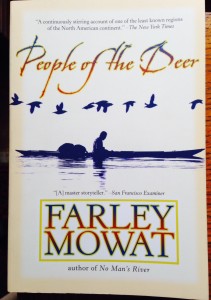 I’m sad about Farley Mowat’s passing. What a great Canadian, and such a conscious dweller on the planet. He righteously raged about ill treatment of people and wildlife and abuse of water and air long before Earth Day was a yearly observance. Margaret Atwood’s praise is fulsome:
I’m sad about Farley Mowat’s passing. What a great Canadian, and such a conscious dweller on the planet. He righteously raged about ill treatment of people and wildlife and abuse of water and air long before Earth Day was a yearly observance. Margaret Atwood’s praise is fulsome:
“Farley Mowat’s books have marked Xs in the sand, and have struck their own igniting sparks….His rage can be Swiftean, his humour Puckish, but his compassion for all creatures great and small has been consistent.”
I had the privilege of publishing three of Farley’s books in the States, including a revival of People of the Deer, his debut, first published in 1951, about the prodigious caribou migrations in the far north which he observed as a young scientist, and the indigenous peoples who relied on the herds for their subsistence and sustenance. He focused on a particular tribe, the Ihalmuit, who had been very badly treated by the Canadian government. He reported on it all in compelling detail and with a fluent narrative that was inherently enjoyable; for an avid reader, this book, all the books of his that I’ve read—about fifteen out of his forty or so titles—were so enjoyable, they practically read themselves. His books were often secular crusades for better treatment of wild things. Though I never met Farley, and only spoke with him briefly one time by phone, I’ve long felt a personal connection to him. I read his best known book Never Cry Wolf, for a middle school class, always remembered his name, and looked for his titles. In early adulthood, when I opened Undercover Books with my family, we ordered, stocked and sold Farley’s titles. Later, as an editor and publisher I began looking for Canadian books to which I could acquire the rights to publish in distinctive US editions. I enjoyed presenting Canadian culture to Americans.
In the autumn of that year we were touring Cape Breton Island and driving its scenic Cabot Trail—think of it as the Big Sur of North America’s east coast—when we came upon the wee village of Margaree Harbour, hard by the Gulf of St. Lawrence. We stopped at a local establishment called the Hungry Piper Gift Shop & Tea Room, a charming spot that sold woolens, tartan ties, Celtic music cassettes, items emblazoned in Gaelic, Cabot Trail postcards, local crafts, and served light fare. We soon met the shop’s proprietors, the May family, a clan with whom Kyle and I became fast friends. They were John and Stephanie May, a married couple, and their grown son Geoffrey, married to Rebecca Lynne. We learned from Stephanie, a voluble storyteller, that they’d come from Connecticut originally, and that they’d moved north during the Vietnam War, lest Geoffrey be exposed to the U.S. military draft. John had held an executive position with an insurer in Hartford, and Stephanie was politically active, working for a nuclear freeze and on the McGovern for President campaign in 1972—alongside a young Arkansan named Bill Clinton, who had been elected U.S. President in 1992. The Mays’ decision to move was also triggered after Stephanie discovered she’d earned a spot on President Richard Nixon’s sinister “enemies list.”
By 1993 when we met, the Mays had been thoroughly ensconced in Canada for almost twenty years. On the property with their shop was a sort of derelict schooner, rather incongruous in their parking area. Upon close inspection I saw emblazoned on the side was the name “The Happy Adventure,” the very boat that Farley Mowat wrote about in his very funny book, The Boat Who Wouldn’t Float. (It opens with him buying the boat at an auction, going halves on it with his friend and publisher, Jack McClelland of McClelland & Stewart.) The Mays were friends with Farley, who donated the broke-down vessel in hopes it would prove a tourist attraction for them. 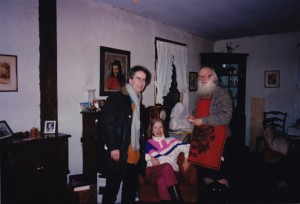
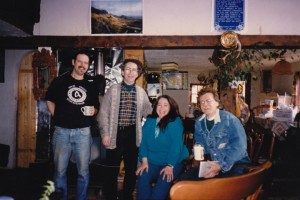
Stephanie and John had another child, a grown daughter named Elizabeth who was the head of the Sierra Club of Canada, living in a distant city. She owned a little house, also in Margaree Harbour, not in use, which the Mays suggested we could rent during our stay. Kyle and I took them up on it, and with a spirit of adventure undimmed by the fact the house had little heat and hot water, we loved our time there, nearly a week. I had a portable radio with me, and so got to hear the Toronto Blue Jays win the World Series, when Joe Carter hit his walk-off homer in Game 6, made indelible by his jubilant romp around the basepaths. A couple nights later we joined Geoffrey and Rebecca Lynne at their home for dinner. This happened to be the day of a Canadian federal election, and Geoffrey invited us to stick around and watch election returns with them. It turned out to be an amazing night, as this was the election in which the federal tories were entirely swept out of power in one of the most lopsided defeats ever in the history of modern elections. It was a celebratory evening—for comparison’s sake, imagine all Republican officeholders in the U.S. losing on the same day!
Our landlord for the week, Elizabeth May, has since become an important Canadian politician, leader of Canada’s Green Party, and the first Green Party member of the Canadian Parliament. Elizabeth has been giving some very moving interviews today, about the long friendship she and Farley shared, including one on CBC’s As It Happens. She had been looking forward to wishing him a happy 93rd birthday, which would have come next Monday, May 12. She also put a moving statement on her website. I remain in touch with Geoffrey May, an advocate for Gaelic education. The books of Farley Mowat, and road trips like the one in Cape Breton, have made Canada an indelible part of my mental and emotional landscape. I’m sorry he’s gone, but marvel at the thought of his forty books, translated in to more than fifty languages, selling collectively some fifteen million copies. What a grand authorial career. In the gallery below are pictures of all of Farley’s books in my home library.
August 30, 2015 update: Sad word this morning brings news of the death of Oliver Sacks at age 82. It was an honor and a privilege in 2006 to publish an essay by him as the Afterword to Howard Engel’s ingenious mystery novel Memory Book, a piece that was also published in The New Yorker. The novelist consulted with Dr. Sacks after he’d suffered a stroke that left him with alexia sine agraphia, aka word-blindness, a condition that leaves a patient unable to read, though able to still write. Sacks continued writing about Engel’s condittion in subsequent years, with a 2010 New Yorker piece and then in his 2010 book The Mind’s Eye. (If as a tribute to Sacks The New Yorker opens its online archive outside their paywall I will link to the articles here.) The blog post below, written in 2013 as a tribute to Engel now stands also as a testament to the generosity and curiosity of Dr. Oliver Sacks, RIP.
—-
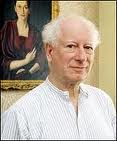 I’m very happy to see that Canadian mystery author Howard Engel—author of Memory Book, a Benny Cooperman Detective novel with an Afterword by Oliver Sacks, which I published in the US in 2006—will receive this year’s Grand Master award from the Crime Writers of Canada. Their announcement reads,
I’m very happy to see that Canadian mystery author Howard Engel—author of Memory Book, a Benny Cooperman Detective novel with an Afterword by Oliver Sacks, which I published in the US in 2006—will receive this year’s Grand Master award from the Crime Writers of Canada. Their announcement reads,
The Crime Writers of Canada has. . .added an eighth prize to their list of awards this year. The CWC Grand Master Award for Crime Writing in Canada will go to a Canadian crime writer with a substantial body of work that has garnered national and international recognition. This year the award will go to Howard Engel, author of the award-winning Benny Cooperman detective series.
Engel is a gem. Here are some of the words his fellow writers have used to describe him:
“Benny Cooperman is a lot of fun to hang out [with]. I’m delighted to see him getting into trouble again.”—Donald E. Westlake
“Mr Engel is a born writer, a natural stylist…This is a writer who can bring a character to life in a few lines.”—Ruth Rendell
“Engel can turn a phrase as neatly as Chandler…Benny Cooperman novels [are] first-class entertainment, stylishly written, the work of an original, distinctive, and distinctively Canadian talent.”—Julian Symons
The prolific Sacks, neurologist and author, contributed an essay to Engel’s book because he was fascinated by a condition the author had endured. Engel wrote Memory Book after suffering a rare kind of stroke that left him with alexia sine agraphia, aka word-blindness. He was no longer able to read, but somehow still capable of writing. Painstakingly and ingeniously, Engel placed his protagonist, private eye Cooperman, in a similarly perplexing condition. According to a post by blogger Allyson Latta, Sacks still consults with Engel from time to time on the mysteries of his condition. Showing that the writing of Memory Book was no fluke, in 2008 Engel published his twelfth book in the Cooperman series, East of Suez, and in July 2014 he will publish City of Fallen Angels, featuring a new series character, Mike Ward. I’m very glad this recognition is being given to Howard Engel, and I’m also very happy for his agent, Beverley Slopen.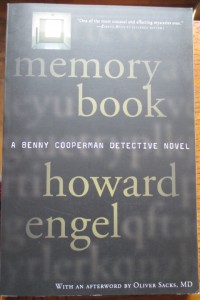
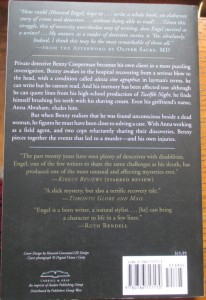
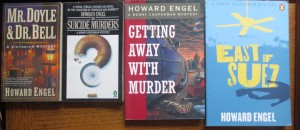
As the LA Times reports this afternoon, ongoing litigation that is challenging the proposed Keystone XL pipeline over the probable effects it would have on a key aquifer in Nebraska will create a delay of several additional months in the Obama administration’s deliberations on the Alberta-Texas pipeline, pushing a decision until after the US’s mid-term elections next November. That’s helpful politically to the president and DEMs for several reasons covered in the story, but there’s an additional effect I don’t mind at all: it shows that ham-handed nudging of the president by Canadian Prime Minister Harper and his ministers, which in one notorious instance slandered environmental groups in Canada and the USA, and efforts mounted by companies like TransCanada, haven’t amounted to much in the way of effective pressure on the administration. If anything, it makes Harper look weak in regard to oil policy, supposedly his strength. That, plus significant challenges to the pipelines out west, including from First Nations Canadians, should set Harper back on his heels, even as the 2015 Canadian federal election nears.
I’m pleased as an American who follows Canadian politics, and as someone hoping to see the Alberta tar sands–with their high cost to the environment, and whose end product would burn with high emissions–stay in the ground. I’m also pleased that it displeases PM Harper and the drill-baby-drill crowd in the US, frustrating their zeal to exercise rapacity toward natural resources and the environment.
This forthcoming book was announced in PublishersMarketplace.com’s daily deal newsletter today:
Anna McGarrigle and Jane McGarrigle’s story of the McGarrigle sisters, the Canadian singer-songwriters who became famous during the folk music revival of the 1960s (the other half of the duo, Kate, passed away in 2010), recounting their family story, idiosyncratic upbringing, and musical influences, to Amanda Lewis at Random House Canada, for publication in October 2015 (world rights).
As a tribute to these great musical sisters from Montreal, here’s a video of them performing their achingly beautiful song, “Heart Like a Wheel,” with a group that includes Linda Ronstadt and Maria Muldaur. Note: Kate is playing piano, while Anna is standing, second from the left, next to Linda Ronstadt. I wonder if there will be a US edition, or just distributed copies of the Canadian edition in the States?
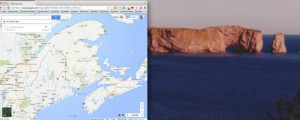 Over the past couple days, I’ve been looking at old photos I may scan and use to illustrate posts I plan to publish on the two blogs I manage–it’s rewarding work, especially the more I really dig in to the task and decide what to post. Even with the pictures I’m unlikely to use, it’s fun to be reminded of things I’ve done and places I’ve been over the years.
Over the past couple days, I’ve been looking at old photos I may scan and use to illustrate posts I plan to publish on the two blogs I manage–it’s rewarding work, especially the more I really dig in to the task and decide what to post. Even with the pictures I’m unlikely to use, it’s fun to be reminded of things I’ve done and places I’ve been over the years.
As an example of the sort of images I’m looking at, here are pictures I took on a three-week solo road trip I made in autumn 1988 to Atlantic Canada, with a culminating day at the majestic Percé Rock (aka le rocher percé or ‘pierced rock’) or in eastern Quebec along the Gaspé Peninsula, a veritable lobster tail jutting in to the Gulf of St. Lawrence where it meets the Atlantic Ocean, as shown on the above map. The rock face sits like the prow of a massive ship, towering nearly three hundred feet above the water. It is approachable on foot at low tide, but even then you have to keep on your toes as winds can shift the waves unexpectedly. The same vacation I also visited nearby Bonaventure Island and Parc Forillon, a serene national park. I toured this area only once, as subsequent trips to Quebec with my with my wife and son never brought us this far east. I would love to return with them some day.
The wikipedia entry about Percé Rock includes a lot of fascinating information, such as the fact that more than 150 fossil species have been found in the locale, with some of the fossils dating back more than 310 million years. Bonaventure Island, which I visited by boat, is home to huge flocks of noisy seabirds, including northern gannets, snowy gannets, and black cormorants, with the pungent tang of their guano filling the air, which in past times local farmers would gather to spread across their fields.
This region left a great impression on me, for as you can see, I chose the image of the pierced rock as the motif for this site when I started it last year, similar to when I chose an image of the George Washington Bridge, aka The Great Gray Bridge, for my first blog, established in 2011. Unsurprisingly, I am not alone in having been captivated by Percé Rock. The wikipedia article reports that French poet André Breton, an exponent of surrealism and friend to Dada artists, visited the rock in 1944, while global war still raged, including at home in France. His sight of the rock inspired a poem, “Arcanum 17,” which he called “a hymn of hope, renewal, and resurrection,” adding that Percé Rock is a “razor blade rising out of the water, an image very imperious and commanding, a marvelous iceberg of moon stone…to a distracted observer though to a common man it is just but a resting place of birds.”
US Natl Archives may've found Lincoln funeral pics unseen for almost 150 years @cbcasithappens http://t.co/gysXrvgXut pic.twitter.com/MnkUqWcK8l
— Philip Turner (@philipsturner) March 21, 2014
When I had my bookstore, Undercover Books, we stocked and sold a majestic photography book called The Face of Lincoln, which collected every known photograph of Lincoln. It came out in 1979. 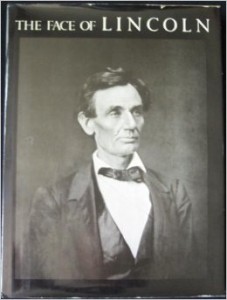 A few years later, I gave it as a wedding present to my Franconia College classmate and close friend Robert Henry Adams, who after college in New Hampshire had moved back to his hometown of Chicago where he became a dealer in rare books, prints, and fine art. The third member of our troika of friendship was Karl Petrovich, a dear friend to both of us. A few years after that, by which time I had moved to NYC, Rob gave me an original Lincoln photograph by Alexander Gardner, a contemporary of Matthew Brady. Sadly, Rob died in 2001, a dear friend whom I still miss all the time. Karl died a few months after Rob, early in 2002.
A few years later, I gave it as a wedding present to my Franconia College classmate and close friend Robert Henry Adams, who after college in New Hampshire had moved back to his hometown of Chicago where he became a dealer in rare books, prints, and fine art. The third member of our troika of friendship was Karl Petrovich, a dear friend to both of us. A few years after that, by which time I had moved to NYC, Rob gave me an original Lincoln photograph by Alexander Gardner, a contemporary of Matthew Brady. Sadly, Rob died in 2001, a dear friend whom I still miss all the time. Karl died a few months after Rob, early in 2002.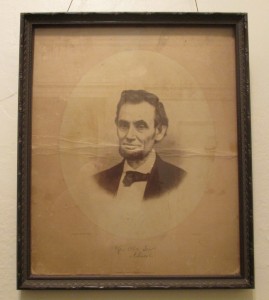
I thought of Rob yesterday when I heard CBC As It Happens’ interview with a US archivist who believes that a fellow staffer of his recently discovered a photograph of Lincoln’s funeral procession as it passed in front of Grace Church at Broadway and 10th Street in Manhattan, near where Matthew Brady had his photographic studio. It’s a segment that would’ve fascinated him, and he would have had an educated opinion about whether these pictures do show the Lincoln funeral. You may listen to the story about the discovery via this link. Along with pictures of The Face of Lincoln and the Lincoln photo Rob gave me here are some more shots: of Rob himself, with me; Karl Petrovich; his wife Sandra Adams; his sons, Jesse and Sam; and my wife Kyle Gallup. Cross-posted at The Great Gray Bridge.
